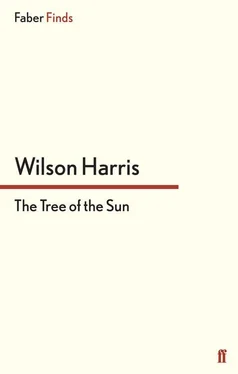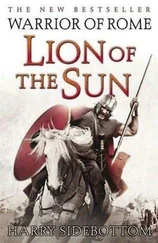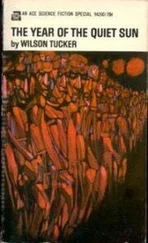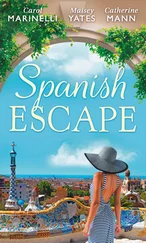Wilson Harris
The Tree of the Sun
For Margaret,
Joyce Adler and W. J. Howard
We are born with the dead:
See, they return, and bring us with them.
The moment of the rose and the moment of the yew tree
Are of equal duration.
T. S. ELIOT
I must hear from thee every day i’ the hour.
For in a minute there are many days.
Romeo and Juliet: ACT III, SCENE V
During a long series of feuds and battles with the Caribs the Arawaks used to climb into the sky by means of a foodbearing tree. One day their enemies set fire to the tree. It blazed across the oceans and as it fell there was an explosion like thunder. The Indians who remained in the sky turned into stars and formed the constellation of the Pleiades.
GUIANESE ARAWAK AND MACUSI CREATION MYTH
Da Silva painted lines of snow far above Tenochtitlan, ancient Mexico, in the seemingly breathless air of extinct volcanoes through which the conquistadores came….
He painted their descent into a green field that bordered a balcony on which the sun-king Montezuma stood. He painted the sun-king retiring into his palace; painted the blow he received from the hand of the conquistadores, from the hand of his own people as well. A blow that was but a glancing blow, that left him untouched, or, on closer scrutiny of the canvas by each eye within or without it, so subtly bruised as to appear scarcely wounded at all. So that his death from the blow he received was a mystery to those who were in attendance upon him. It was as if he wished to go, to slip away from them when they least bargained for it and as he died he secreted his last thoughts about brute assassin threaded into paradoxical arrow of liberation or tenderness within the wall of extinct volcanoes far overhead or within the gorgeous apparition of the sun painted indoors close to the bed on which he lay. His was a death-mask of the elements’ interchangeable ruses of tyranny and love, seasonal birth and seasonal resurrection, each day’s carpet of earth, each day’s tree of the sun, each day’s journey backwards or forwards in time, each day’s everlasting feud…. Yet pattern of relief.
Da Silva glanced away from the Montezuma mural that he had scarcely begun, despite his intense speculations about each line he had begun to sketch or paint, towards a blue winter sky over the city of London in which he lived in the year 197– with his wife Jen. She was Peruvian-born; he had lived in England since the age of five but his birth place was Brazil and his antecedents were Arawak, European and African.
A mild sun shone that seemed closer to spring than winter and was reflected in a window in a block of flats across the way, across a tennis court that ran beneath his studio, as if the two suns — one in the sky, the other capable of multi-reflected frames on earth — existed now from a single toss or shaft of light other than immediate manifestation or immediate reflection. An electron arrow of painted consciousness the sun was with a capacity for double penetrations, double hurdles, multiple penetrations, multiple hurdles, through the walls of space.
There was a horsechestnut tree close to the window of his studio and each naked branch seemed drawn there now by an inimitable hand, da Silva thought, that led one back into the fires of autumn or forwards into embryonic tapestries of spring.
At its extremities the wood seemed splintered into a delicate lacework or spreading bridle and rein of resources in the hand of rider on horse sculptured into the tree. The fossil blood (reds, yellows, browns) that painted each dying or dead leaf in beautiful October into early November had rained from the centaur spirit of the tree into the late carpet or miraculous battlefield of autumn as if all places around the globe witnessed to and mirrored an event, half-tragic encounter of heterogeneous cultures, half-fateful spectre of the nature of history.
Da Silva turned from the view outside his studio to his own gigantic painting, a huge leaf of a canvas that covered one wall of the room, and sought now to trace with a nail or a finger an almost imperceptible line of blood that ran along Montezuma’s pagan temple, a faint bruise from the glancing blow he had received from the hand of enemy or friend.
The autumn and winter and cruel spring of the modern world seemed to cluster there in that line, shadow of indeterminacy, stone or arrow, splintered lacework, remembered dying and living cavalry seasons in the head of sunking and snow-king.
In the bottom right hand corner of the mural da Silva could see the outlines of his own Brazilian signature already planted there, Da Silva da Silva (Christian name with a capital D, surname with a common d). It swam, yet stood, in the base of the canvas, as if it were part of a sacrificial seed in soil and water written into silver and gold to make a mercurial distinction in itself beyond itself, to mirror and repudiate subtly, unselfconsciously perhaps, a tautology of identity in painter as well as painted subject….
Jen came into the studio now with a morning tray and cups of coffee; sat in a chair at the edge of the painting, close to the window, seemed all at once an extension of paint herself with a capacity to mediate between sun-king and snow-king, between conception of the sky outside the studio and conception of volcanoes inside upon a canvas in the studio.
He saw her all at once in that light of mediation reflecting anew his astonishment and tumultuous joy at news she had given the evening before. The news hung there now as her eyes met his in the pendulum of a clock in lines of paint swinging back, swinging forwards, a field of grass, brushstroke or waving sea, from which a blade rose up nevertheless unfalteringly as the seeded blow of time. Retina of the womb.
“It’s marvellous”, he paused, sipping his coffee, “and terrifying,” he added quickly. “I’m not cut out to be a father, Jen.” He laughed. The black liquid glinted, a star. “Or am I? I can hardly believe it.”
She smiled against the field of grass that blew in his canvas. “Me too,” she said. “It’s eight years we’ve been together. A long time it’s been. And yet perhaps it’s happened at the right moment.” She changed the subject abruptly. “I don’t remember this.” She was staring at the Montezuma conception of a painting that extended from her side across the wall. “What’s it called?”
“The tree of the sun. I started to paint it two months ago. The very morning you and I …” he paused—“the very morning that it happened. Two months pregnant this painting is.”
He put the cup down, took up a brush and pointed it at her. A blade of grass stirred. Mediation of light. Branching irrational thread of antecedent and existent times. Outer flesh. Inner cavity, flesh. God-made, goddess-made, climax. Creation. And da Silva in turn was impregnated by a tree of pleasure, potentiality, voices in leafy canvas or wood.
“The very morning,” he repeated, “two months ago, when our child was conceived. I knew it then . It was then I began this.” He tapped the canvas, stopped and thought in himself—“I had a rooted feeling then. An ear in the heart of the ground. An eye in the middle of wood. A hand uplifted…. It was early. I got up, came into the studio with the warmth of your body still upon me. The studio was cold, a cave. Perhaps I dreamt it all, who knows? The tender assassin who creates the paradox of the globe. I began to paint the blow of creation before I could properly see it on my own brow as upon that of others, to paint an ice-age tree of love before I could properly feel it in my own crucifixions of lust as in the naked appetite of others, a foodbearing tree nevertheless, the execution of a seed of light, the miracle of branches of dawn, the complex blood of dawn that resembles a break — a pattern of relief — in a body of darkness.”
Читать дальше












